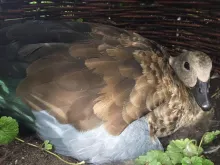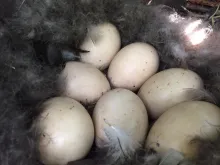
Blue-winged Goose (Cyanochen cyanopterus)
Species name
- Dutch name:
- Blauwvleugelgans
- English name:
- Blue-winged Goose
- German name:
- Blauflügelgans
- French name:
- Ouette à ailes bleues
- Scientific name:
- Cyanochen cyanopterus
Scientific classification
- Order:
- Anseriformes
- Family:
- Anatidae
- Onderfamilie:
- Chenonettidae
- Genus:
- Cyanochen
Description
- Description:
This is a stocky grey-brown bird with a slightly paler head and upper neck. The plumage of these birds is thick and loose, furlike as an adaptation to the cold.
Male:
Have brownish-grey plumage, which is darker on the upperparts and paler on the forehead and throat. The feathers on the breast and belly have pale centers, resulting in a mottled appearance, and the tail. The feathers of the wing have a faint metallic green sheen and the upper wing coverts are pale blue. legs and bill are black.Female:
Similar to male but smaller best if compared in a pair.Juvenile:
Blue-winged geese are similar in appearance to the adults, other than their wings lack the green gloss.
Standard Measurements
- Body Length (cm):
- The male (drake) of the Blue-winged Goose measures approximately 65-75 centimeters. The female measures approximately 65-75 centimeters.
- Body Weight (grams):
- The male will weight about 1800-2200 gram. The female will weight about 1520 gram.
The weight is notoriously variable and can only be used as indication!
- Note:
During the mating season the male blue-winged goose struts his stuff with his head bent over his back exposing his blue wing patch for her to inspect. The courtship and breeding takes place by lakes and streams in the mountains and they build their nests in among grass tussocks.
- Breeding:
- The female Blue-winged Goose usually lays from 4-7 creamy white eggs and incubates them for 30-32 days.
- Artificial incubating:
The ideal relative humidity for incubating most waterfowl eggs is 55% (ground nesters) and 40% (cavity nesters). The temperature is usually 37.4°C. Set ventilation as recommended by the incubator manufacturer. Eggs must be turned, either automatically or by hand, a minimum of 4 times a day. As the duckling develops there is a loss of water from the egg and the air sac gets bigger. In normal development of an egg with a 30-32 days incubation, the air sac occupies about a third of it three days earlier. Cleanliness is vital and ideally eggs should be moved to a separate hatcher at this point, where the humidity should be increased to 65% and even higher once they have pipped internally.
- Bird banding:
- Recommended closed leg band ring size for the Blue-winged Goose is 14 mm.The leg band ring can only be applied on a young goose at around 12-14 days old.
- It doesn't matter what leg that you band, but it's good to have a consistent system. Suggested: Left leg = Female, Right leg = Male
- Rearingfeed:
-
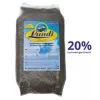
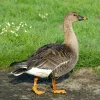

Floatable special rearing feed for all types of aquatic ornamental fowl - especially for the cultivation of trees as well as greening ducks.
This well-balanced complete feed with 20% protein content convinces above all by its good compatibility and forms the basis for visibly healthy growth from day one.
Made exclusively from wholesome and selected raw materials, Lundi Micro Regular is also ideally suited for the year-round feeding of waterfowl.
- Maintenance food:
-



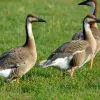

Lundi Regular with a protein content of 20%, valuable Spirulina and high-quality by-products is optimally balanced in its composition maintenance food for water ornamental fowl of all kinds. Especially green teal and Whistling ducks that are not dependent on a very high protein content, are well supplied.
Lundi Regular contains all the minerals and vitamins in full form that are important for the animals. Therefore also suitable as breeding food.


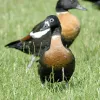


Floating full food for all sea ducks, green ducks, eider ducks and geese, especially in the moulting and breeding phase ideally suited. Packed with wholesome raw materials, natural vitamins and trace elements, this performance food with a protein content of 30% forms the basis for lifelong vitality.

